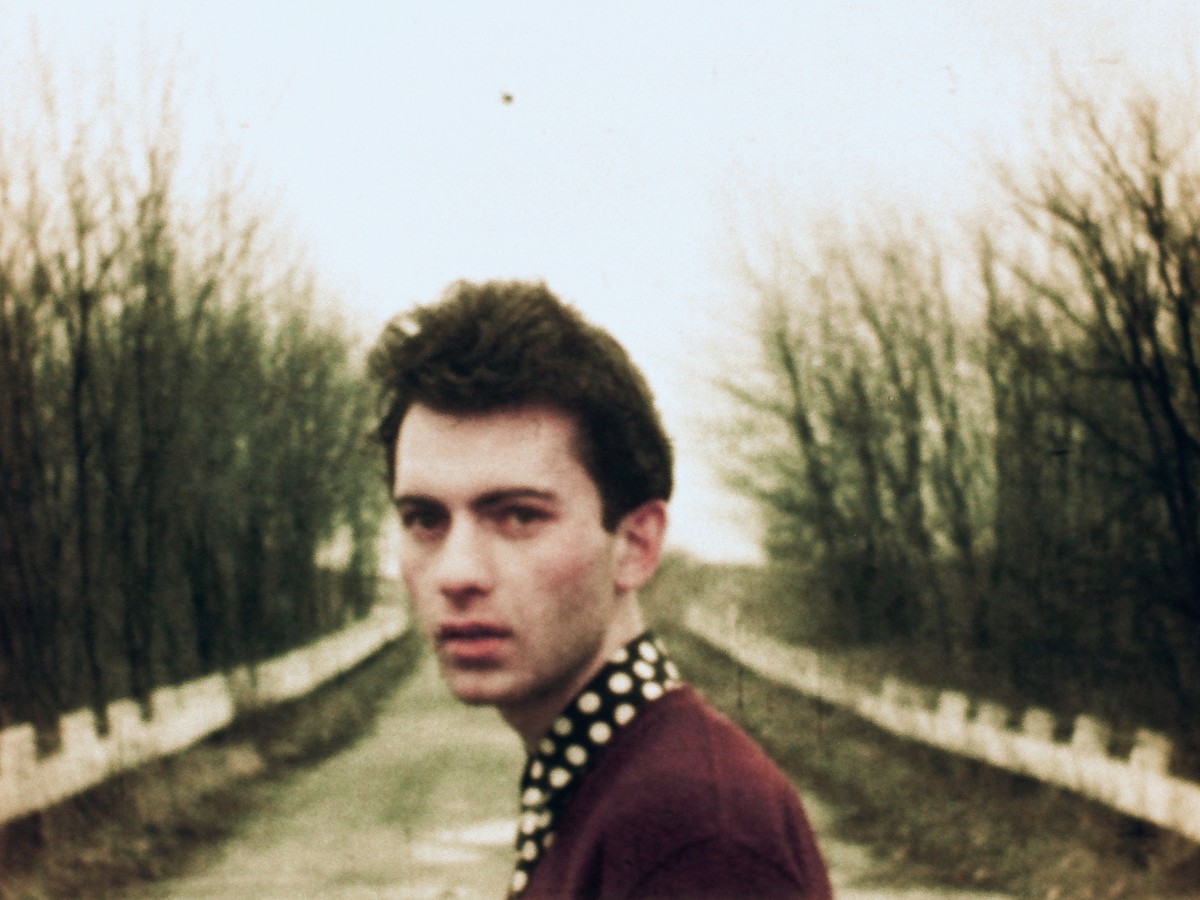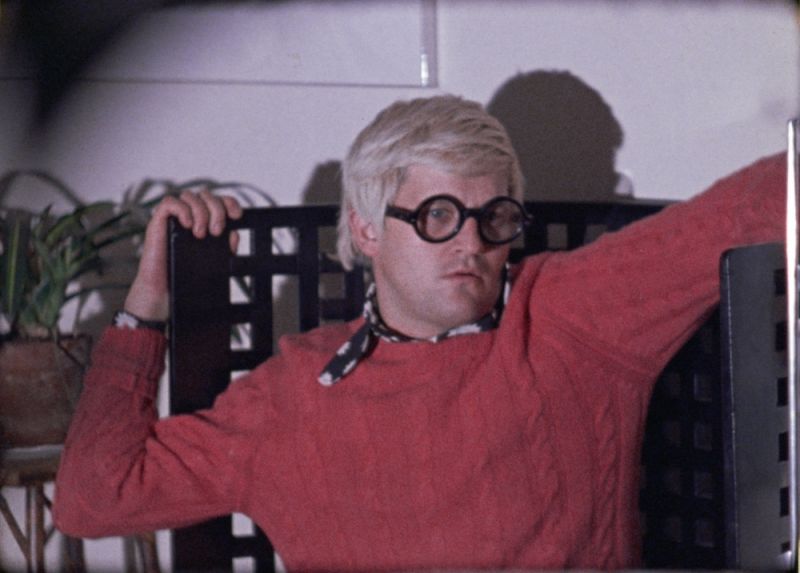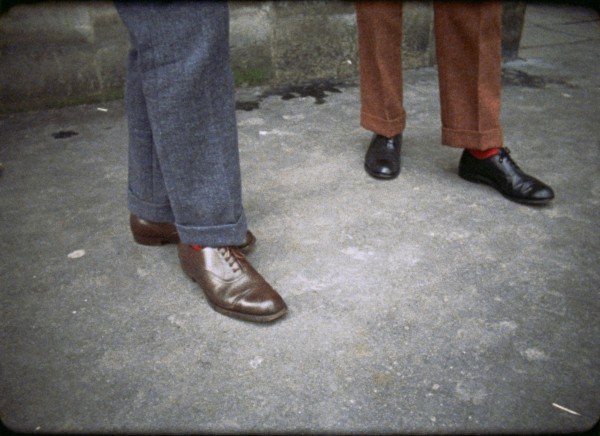* (restored/expanded)

‘One of the most extraordinary American experimental filmmakers of the 20th century, Gregory Markopoulos (1928-1992) also remains one of its most elusive. For more than a decade before his death, Markopoulos—who had emigrated to Europe in 1967, withdrawn his films from circulation, and asked that a chapter on his work be removed from P. Adams Sitney’s Visionary Film—had been disassembling many of his most celebrated films and reworking them, along with some 55 previously unscreened new films, into a final magnum opus, Eniaios, a silent, 80-hour-long epic arranged in 22 cycles. Left unprinted when Markopoulos died, Eniaios (a term evoking unity and oneness, yet a film in which, separated always by lengths of leader, no two images “touch”) is still today being slowly processed and projected for the faithful once every four years at the outdoor theater known as the Temenos—a place “cut off” from the everyday and reserved for contemplations of divinity—established by Markopoulos and his partner, the filmmaker Robert Beavers, in the mountain village of Lyssaraia in Greece. Only eight of the 22 cycles, each running between three and five hours, have been screened thus far.
‘“I propose a new narrative form through the fusion of the classic montage technique with a more abstract system,” wrote the filmmaker in 1963, in one of the essays collected in Mark Webber’s invaluable Film as Film: The Collected Writings of Gregory J. Markopoulos (The Visible Press, 2014). “This system involves the use of short film phrases which evoke thought-images. Each film phrase is composed of certain select frames that are similar to the harmonic units found in musical composition.” Markopoulos spent much of his career focused on various methods for editing and interrelating “short film phrases” and individual compositions (of often inanimate objects, emptied rooms, and unpopulated landscapes) in elaborate patterns, and finally on the effects of individual frames as they puncture and punctuate passages of darkness—like flashes in a night sky, or musical notes suddenly piercing silence. Eniaios is the complex culmination of this life’s work, but aspects of its nascent form can be glimpsed in 1968’s Gammelion, a 54-minute portrait of the much-storied castle of Roccasinibalda in Rieti, Italy, made from only six minutes of photographed footage: each image fleetingly appears and reappears, interwoven in a thousand slow fades and myriad combinations with lengthy passages of black and clear leader.
‘Shortly before relocating to Europe, Markopoulos had also developed a personalized method for composing and editing certain films entirely in-camera. In the eventually restored Markopoulos chapter of Visionary Film, Sitney (still the filmmaker’s greatest admirer and exegete, and Artforum’s Temenos correspondent) explains: “Carefully watching the frame-counter on his camera, [Markopoulos] would expose a number of takes of one image interspersed with blackness, achieved by covering the lens with his hands or the lens cap for as long as he wanted, or by using the automatic fading mechanism of his Bolex camera, all with different nuances. He would then rewind the film and expose the units of the next view, detail, or object.” Both the lush 1966 apartment portrait Ming Green and 1967’s Bliss, a study of a Byzantine church on the Greek island of Hydra, utilized this technique, the cumulative effect of which finds beautifully composed, naturally lit images appearing from and disappearing into darkness, often superimposed upon one another in extremely specific ways—like panes of illuminated vapour in a chimerical piece of leaded glass.
‘Markopoulos’ brilliance as a composer with light may owe a debt to his studies with Josef von Sternberg while a student at USC, but like so much related to the filmmaker’s immense cinematic legacy, speculation only goes so far. Fortunately, Webber and Beavers occasionally travel with and exhibit the films in their original forms: I caught Bliss and Gammelion earlier this year courtesy of Los Angeles Filmforum and Redcat. Beyond that, well…there’s always Lyssaraia.’ — Chuck Stephens
___
Stills




























____
Further
Gregory J. Markopolous @ IMDb
Film as Film: The Cinema of Gregory Markopoulos
A Pilgrimage to the Peloponnese: Gregory Markopoulos, Eniaios and the Temenos
Gregory J. Markopoulos @ Experimental Cinema
STAN BRAKHAGE ON GREGORY MARKOPOULOS & JIM DAVIS
Gregory Markopoulos @ Mark Webber
Gregory J. Markopoulos and the Cantrills
THE WRITINGS OF GREGORY J. MARKOPOULOS
Like Being in a Rainbow: Gregory Markopoulos and the Temenos
Daily Briefing. Bill Morrison, Winsor McCay, Gregory Markopoulos
ROBERT TODD / To Gregory Markopoulos
Queer & Now & Then: 1949
GM @ Making Light of It
The Song of the Poet ; on Gregory J. Markopoulos
Film Grows Unseen: Gregory Markopoulos, Robert Beavers, and the Tectonics of Film Editing
Seconds in Eternity: Experimental Film Master Gregory Markopoulos
____
Extras
Gregory Markopoulos & Robert Beavers in 1987
“Andy Warhol, Gregory Markopoulos et Cinématon au Jeu de Paume” (2014) by Gérard Courant
Ute Aurand and Robert Beavers discuss the legacy of Gregory J Markopoulos
____
Interview with Robert Beavers
from Lumiere

We believe that some films such as Christmas U.S.A., Eldora, Serenity, The Divine Damnation, Gammelion, Index – Hans Richter, Hagiographia or Moment are not preserved in The Temenos Archive. Is this true? Is a priority on the part of The Temenos that all Markopoulos’s film copies could be found there – apart from other places?
Christmas U.S.A. and Eldora have recently been preserved through new internegatives made by Temenos Archive. Serenity is lost for the time being. The single existing copy of The Divine Damnation rests in Anthology Film Archives. Gammelion has been preserved by Österreichisches Filmmuseum. And the only existing copy of Index – Hans Richter is in the Österreichisches Filmmuseum. There are two versions of Hagiographia; the splices in the first version were defective and turned magenta. One copy of this version is in Anthology Film Archives and the second version was refilmed and is the main film in Eniaios V. Moment, if I remember correctly, is a portrait of Barbara Hepworth, and the only existing copy is in the Österreichisches Filmmuseum.
In some cases (Alph, Doldertal 7, Saint Acteon, 35, boulevard General Koenig) the original reversal film is deposited in The Temenos Archive. Will you try at any point to restore them?
Yes, we hope to restore a number of these films. Three of the four film titles that you mention were incorporated into Eniaios.
What does Sitney mean when he talks about the “reediting of his entire corpus”? What did this reediting involved? What is exactly Eniaios?
The creation of Eniaios was a process that began by Markopoulos making corrections in some of his earliest films, then he came to the decision to discard the existing soundtracks; and he had conceived the idea of the Temenos and was continuing to produce new films that he edited but chose not to print. At some point in the mid-70’s -I have a clearer sense of the place, Champéry, than of the year- he began the process of organizing all of the existing films into a new form, and finally reached the interwoven composition of Eniaios, in which reels of different films are composed into the unit of each “cycle” or “film order”. Each of these multi-reel compositions has its own individual title and there is a progression from the first to the 22nd cycle. The first five are listed in our Temenos 2008 program and the next three will be listed in our new one.
In this sense, what do these “about one hundred films” involve?
They are the summation of Markopoulos’s filmmaking and give it a unified form. Other qualities that are in his earlier work may be lost, but there is a remarkable gain.
Is it true that it would take more than eighty hours to project Eniaios?
I cannot give you an exact length in minutes for Eniaios. It has 167 reels and at some point I must have reached an approximate calculation of 80 hours, but I could be mistaken…
Is it true that you started to rework your films until arranging in three cycles My Hand Outstretched, continuing in a certain sense the example of Markopoulos with Eniaios?
My decision to re-edit many of my films also began with the intention to “correct” some of my earliest films, but I kept them in chronological order and compressed the length of these early films often to half their original length, and I devoted a number of years to editing new sound tracks. I cannot describe the complex back and forth of inspiration and conflict that existed; most of my filmmaking has been in dialogue with Markopoulos, and this continues to some degree although more indirectly.
Did you work in parallel on these projects?
Yes.
How were those working days?
Usually quiet. Often interspersed with crises related to lack of funds.
Did you use to edit in the same place?
Sometimes in connecting rooms.
Given the date which appears in the Temenos website, 1948-1990, should we understand that Markopoulos began “shooting symbolically” Eniaios in 1948?
No. This date means that the films incorporated into Eniaios date between 1947 and 1990. The initial decision about the form of Eniaios came in the 1970’s and it was often revised up until its completion in 1991.
1948 is the year in which Markopoulos finished his film Du sang, de la volupté et de la mort. Can we in any way understand that this is the first film he reworked at the beginning of the Eniaios project?
Du sang, de la volupté et de la mort is the earliest film incorporated into Eniaios, but it was not the first film that he edited for Eniaios. For a long while he was not certain whether he would include the trilogy1 in Eniaios. Then he found how he wanted to re-edit it and has placed the re-edited version in the first cycle of Eniaios.
Is there any kind of correspondence between the material we can see in each one of the first cycles of Eniaios and the chronology of his filmography?
Outside of the trilogy being in the first cycle, I can see no correspondence between the chronology of his filmmaking and the order of films in Eniaios.
An illustrative example: someone who knows well a film like Twice a Man, perhaps one of Markopoulos’s most seen works… What would he find of it in Eniaios?
There are four reels of images from Twice a Man in Eniaios, in the film orders IV, VIII, XV and XIX.
Do you think that, regarding the previous films, their previous “incarnations” have been “discarded”?
Not for me. I see them as two separate works. Markopoulos acted as if he thought they were discarded. He probably had to think that, but then at one point he said that it might have been a good idea, if we had made internegatives before he began editing Eniaios!
It’s been written that Eniaios could be thought as an “incomplete file” or a “ruin”. Do you agree with that?
Sometimes, when I am in Greece, or when I think about Hellenism and relate it to the fragile state of the Eniaios film originals, in which most of the tens of thousands of film splices need to be redone before the films can be printed, the thought of “ruin” takes on a special meaning. But I do not think that either terms describe this work correctly.
Could this “ruin” idea also be related with The Temenos environment in Greece?
When I think of the Temenos environment, I think of the generosity of Nature…
The black & white “frames” are present all over Eniaios? Is it true that they do not only respond to an structural program, but rather open themselves as a dream space?
Some films are edited using only lengths of black between the chosen images. The reels of The Illiac Passion for example. Other films have both black and transparent film between the images. I would say they have both a structural program and are a dream space.
In some films, Markopoulos overexposed or underexposed the frames or he made superpositions, all with the camera. Are these effects preserved in Eniaios?
Yes, these effects (overexposed or underexposed frames, superpositions) are preserved in Eniaios.
Why the so-called “dedication to Herakles”? And why is Eniaios cycle IV entitled Nefeli Photos? What does the title refers to?
The so-called dedication reel is of the archeological site, Pyra Heracleos. And the Eniaios IV cycle’s title Nefeli Photos refers to the light of the moon.
Is it true that Gammelion is the film that looks the most like Eniaios?
Gammelion is a very important step along the way.
Is it true that the shots normally last for a few seconds, and sometimes a single frame?
Frequently, a single frame.
What is left from the three axes of research of Markopoulos -interpretations of literature or mythological sources, portraits of individuals and studies of locations or architecture- in Eniaios? Have these axes disappeared or have them been reinforced?
All three thematic sources are present in almost each cycle.
At the editing of Eniaios, did Markopoulos go back to the rushes of all his previous films?
He went back to the films that he had already edited. Not all of them but most.
What was the difference between those sequences he had edited in the editing table and those others he had assembled in the camera?
This needs a more precise answer than I can give you. There is an organic quality resulting from the in-camera editing that results from filming within a single location. The way of filming with superimpositions meshes elements together to create new metaphors. It also possesses other rhythms.
Did Markopoulos conceive Temenos as the only possible place to project Eniaios or was he open to the possibility that the cycles were projected elsewhere?
The Temenos was conceived as the only place.
_____________
13 of Gregory Markopoulos’s 32 films
_____________
Christmas, U.S.A. (1949)
‘Gregory J. Markopoulos’ 1949 work, Christmas, USA is a trance film that pretends, at least, on the surface to be a film about the central figure’s homelife. At the beginning of this completely silent film (shown originally without musical accompaniment) we see a handsome male wanderer in an amusement park, “The Cavalcade of Worlds” wandering through the park through the various rides (a merry-go-round, a ferris wheel, etc), through the back alleys of freak shows, and past the dance and music halls of “Little Harlem.” At the same time, our young hero awakens, washing, putting on a fashionable bathrobe, and later shaving. He receives a phone call and speaks for some length. We observe another boy wandering, this time through a woods, dressed in a Japanese robe, lighting what appears to be a ritual lamp, while the boy on the phone continues to play with a letter opener and other nearby objects, which also appear, through Markopoulos’ editing, to be somewhat ritual in nature. Are these the same person, including the man we’ve seen meandering through the amusement park?’ — Douglas Messerli
the entire film
__________
Swain (1950)
‘Features a dreamlike narrative of a young man’s ritualized rejection of heterosexuality, as a mysterious woman in white gossamer pursues him through a ruined landscape.’ — Arlessdeg
the entire film
________________
Twice a Man (1963)
‘Twice a Man re-invents the Greek myth of Hippolytus, killed after rejecting the advances of his stepmother Phaedra. The story is transposed, and deeply transformed, to 1960s New York. Here Paul, a contemporary Hippolytus, envisions fragments of the most relevant relationships in his life: his seductive mother, shown in both a younger and an older version, and his male lover, named the Artist-Physician and representing the creative self. With sharp, richly textured and sensuous colours, the images displaying thoughts and memories of the characters interweave in a brilliantly innovative montage, the point of reference always sinuously shifting from one persona to another and almost evoking an intertwining of identities.’ — Eleanora Pesci
the entire film
____________
Galaxie (1966)
‘In March and April of 1966, Markopoulos created this filmic portrait of writers and artists from his New York circle, including Parker Tyler, W. H. Auden, Jasper Johns, Susan Sontag, Storm De Hirsch, Jonas Mekas, Allen Ginsberg, and George and Mike Kuchar, most observed in their homes or studios. Filmed in vibrant color, Galaxie pulses with life. It is a masterpiece of in-camera composition and editing, and stands as a vibrant response to Andy Warhol’s contemporary Screen Tests.’ — letterboxd





________________
Ming Green (1966)
‘In early spring of 1966, in anticipation of his eventual departure from the Greenwich Village apartment in which he had been living for a number of years, [Markopoulos] filmed the revelatory seven-minute interior portrait Ming Green , titled for the deep spruce color of the apartment’s walls. Ming Green was edited entirely in-camera, and its precise rhythmic blossoming is based on overlapping dissolves and longer flashes, rather than single-frame clusters. The film’s complex harmonic structure, however — as well as its incorporation of often static, “single” images that may be comprised of more than one frame — echoes the montage techniques developed in Twice a Man (1963). Interweaving mementos with foliage, color, and light, Ming Green suggests the inextricability of past and present: despite its exquisite lightness, it could represent the passage of hours and days rather than minutes.’ — Kristin Jones
the entire film
_________________
The Illiac Passion (1967)
‘Throughout his life, Markopoulos remained closely connected to his heritage and made many works that connected with ancient Greek culture. The Illiac Passion, one of his most highly acclaimed films, is a visionary interpretation of ‘Prometheus Bound’ starring mythical beings from the 1960s underground. The cast includes Jack Smith, Taylor Mead, Beverly Grant, Gregory Battcock and Gerard Malanga, and Andy Warhol appears as Poseidon riding an exercise bike. The extraordinary soundtrack of this re-imagining of the classical realm features a fractured reading (by the filmmaker) of Henry Thoreau’s translation of the Aeschylus text and excerpts from Bartók’s Cantata Profana. Writing about this erotic odyssey, Markopoulos asserted that, “the players become but the molecules of the nude protagonist, gyrating and struggling, all in love, bound and unbound, from situation to situation in the vast sea of emotion.”’ — Mark Webber

the entire film
_______________
Himself As Herself (1967)
‘The young hero seems the essence of maleness, yet he’s troubled by vaguely feminine objects. Soon his masculine and feminine selves are intercut, as each of his identities appears to look and gesture at the other. The film, at once melancholy and transcendent, consists of a shimmering, nearly plotless evocation of gender identity in flux through haunting, densely interlaced images.’ — Letterboxd

______________
Through a Lens Brightly: Mark Turbyfill (1967)
‘A short film directed by Gregory J. Markopoulos in 1967, shot on 16mm, depicting the life of Mark Turbyfill—a dancer, poet, and painter from Chicago.’ — bleakoutput
the entire film
______________
Gammelion (1968)
‘Markopoulos’ elegant film of the castle of Roccasinibalda in Rieti, Italy, (then owned by patron, publisher and activist Caresse Crosby) employs an intricate system of fades to extend six minutes of footage to an hour of viewing time. This inventive new film form, in which brief images appear amongst measures of black and clear frames, was a crucial step towards Markopoulos’ final work Eniaios (1947-91). Though seemingly an abstract architectural study, Gammelion is based on Julien Gracq’s surrealist novel Chateau d’Argol, and incorporates elements found at the site to represent the characters and events of the book’s narrative. This was the first film Markopoulos made after relocating to Europe. This exquisite portrait of the interior of a Byzantine church on the island of Hydra was composed in-camera in the moment of filming.’ — The Visible Press
the entire film
________________
(A)lter (A)ction (1968)
‘Videotape, black-and-white, sound; 65 minutes.’

____________
Sorrows (1969)
‘Capturing both the history and decay of a chateau built for Wagner, Markopoulos builds a rhythm collage of images with contrasting depth – deep shots of forests overlayed with close ups of what could either be chipping paint or bark with a slow transition to the interior of this once private and secluded mini-palace. The images themselves can be frenetic and overwhelming, but by setting them to the tune of Beethoven they almost form a sort of dance. Markopoulos also interpolates focal points of light throughout the film, often forcing you as the viewer to recenter your attention for the next ‘scene.’ The light play he creates with the windows near the end is really beautiful, almost strobe-like.’ — Ryan Carroll
the entire film
_____________
Portrait of Gilbert & George (1970)
‘Gregory Markopoulos’ Portrait of Gilbert & George (1970) is a film marked by absence. Though a portrait of the artistic duo, the film indulges in none of the privileging of visibility on which the genre of portraiture often rests… The flow of movement, so crucial to most films, is missing. In its place is a rigorous engagement with the medium’s most basic elements, one that returns the viewer to the stillness of the individual film frame.’ — Erika Balson

_____________
Eniaios (1991)
‘Markopoulos’ monumental final film, the silent 16mm Eniaios (meaning “unity” and “uniqueness”), is made of 55 completely new films as well as re-edited footage from most of his previous films, and meant to supercede them as an integrated epic work. Eniaios contains 100 individual titles in 22 cycles, or orders, of three to five hours each. Many Eniaios imagesare only one frame (1/24th of a second) long, and all are bracketed and isolated from each other by intervening lengths of black and white leader. The unit of the single frame and the still image were preoccupying, essential elements of cinema for Markopoulos: “It is, perhaps, a fallacy to believe that film is constant movement.” He conceived of the spacing among the flickering images in Eniaios with the Greek god of healing Asclepius in mind, in the hopes of nurturing in his spectators a therapeutic form of incubation akin to the sort sick pilgrims experienced by sleeping and dreaming in the god’s temple. He “imagine[d] himself a member of an emergent, select order of psychic healers…possessing the skill to subliminally plumb the pre-verbal mysteries of an archaic past,” Kirk Winslow wrote.
‘Markopoulos spent the final decade of his life working on Eniaios, and created it exclusively for the Temenos site. It was fully edited and notated when he died in 1992, but not yet printed. In 1980, a handful of foreign guests and dozens of visitors from the region, including six priests and their families, had attended the first open-air Temenos screening—a “symbolic effort in [the] direction” of Markopoulos’s ultimate vision.7 Early September screenings continued annually until 1987 (when Beavers and Markopoulos turned their attentions to editing and archiving), followed by the Eniaios premiere (Orders I and II) in 2004 and the second screening (Orders III–V) in 2008. And at the end of this month, about 200 spectators from around the world will gather in Arcadia to see Orders VI, VII, and VIII over the course of three nights.’
This film is an eye-witness of the 2016 Temenos edition
*
p.s. Hey. ** Dominik, Hi!!! You’re most welcome. True, with older films, and nothing wrong with young filmmakers wanting to update the representation of that experience to suit the newer and newer world, but, and I can only speak for myself, coming out was just one of the ways that everything that has ended up mattering to me started. It was just the recipe. But I guess it’s easier to represent than the complex aftermath. After Eights are worth bursting for, or almost. Love being asked to interview Isabelle Huppert for a magazine and saying no, G. ** Darbz 🕷️, Hey! Actually it’s a real dog that was trained to play dead for a lengthy amount of time. Welcome home! Yay re: your rich trip. Coney Island, aww, I haven’t been there in decades. The Animals as in the ‘House of the Rising Sun’ Animals? That’s the only Animals band I know. Hm. I’ve been to Greenlight Books. I think I might’ve even done a reading there. Why are they being so stingy with the testosterone? Fuckers. The only for sure upcoming festival is Frameline in SF in June. But the film is submitted to literally 23 festivals at the moment, and we’ll see how lucky we get. I’ll spread the word when/if we get good news. ‘Chungking Express’ is very cool. I really like ‘Fallen Angels’ by the same director if you want another one. Eat that food this week obviously. ** Derek McCormack, Derek, yay! I’m so happy to have made a successful introduction. Yeah, she’s very clever, no? How are you, great sir? Let’s talk soon. ** James Bennett, I’m sure you got whatever there was to get from ‘Nocturnes’, Onwards. I don’t think I’ve ever read Kingsley Amis. Strange. Let me know if I should proceed. I like the storyline, obviously. And the cover seems to have just the right subtle degree of pedo bait. And the view around it is very British somehow but, wait, is that a palm tree? So how’s it all going? ** _Black_Acrylic, Really glad you like it. Yeah, her John Miller collab excited me too. My life in LA used to revolve around going to art openings. The vast majority of my LA friends were/are artists. And LA being such an asocial, sprawling locale, it was often the only way to see them. ** scunnard, Thanks, pal. In a way, the italicised text was perfect for this … let’s be honest … very lengthy place. ** Carsten, Cool you’re working on the scripts. Sounds super interesting. Um, script-wise, we don’t do improvisation. Sometimes a line turns out not to work in practice so we’ll change or cut it on the spot, but otherwise that part is pretty locked in. With the filming, the shots are set and storyboarded before we shoot, but, if we have time, we do change the shots on set if some bright, better new idea springs to mind in the actual situation. ** Misanthrope, Based on what you say, I would imagine the division will receive your work with wide eyes full of expressions of wonder, and their hands will dip into their pockets as they scurry to tip you. ** julian, Obviously, you being in control of your own music videos is ideal. If you’re going to visualise your music that should be your form as much as the sound aspect. In a perfect world. I think both of the possible Chicago festivals take place in the fall. Fingers crossed. It would great to meet you too. Maybe a SD university would show the film. We’ve shown our fiims at universities before, and that tends to go really well. I’ll look into it. ** Sypha, Hey. My assumption is that the Neo-Decadent writers are at least 50% grandstanders. I can’t believe Justin, for instance, actually believes all that stuff he spouts, but who knows. I liked your interview. Very provocative. Very appropriate. ** pancakeIan, Thanks. ‘Finnegan’s Wake’ is … an experience. But, yes, perhaps not one you would enjoy. I have a fetish for really complicated writing, so it hit the spot for me albeit at excessive length. I have a chip on my shoulder from people never-endingly expressing shock that I haven’t read Proust and declaring that I won’t have had a full life without reading Proust before I die and so on, and my refusing to read him feels very punk, and I like it. ** Steve, Hi. Yeah, sure, agree. I’m just a person who thinks self-identification is a malleable thing, so deciding one is queer is like checking something off your list. Not wholly surprised to hear that about the Pulp album, but unfortunate. I like the new Stereolab album but it also feels like Stereolab doing Stereolab. ** Steeqhen, Nicotine gum fucks up my stomach, but your experience may differ. True, but I suspect that most people only want the films or TV or books or whatever they imbibe to be slop. God knows that, post-internet, the chance to find and experience adventurous stuff is easy enough to do for everyone. Income streams help everything, sadly. ** HaRpEr //, Your observation makes total sense and is not remotely stupid. You, stupid? Psshaw! To me what makes ‘120 Days’ a great novel is that Sade ran out of time such that it ends to with those unfinished to-do lists. Those lists and the writing in them is what’s really innovative about the book. People have argued that that mistake is the father of post-modern literature, and I think they have a point. Yes, all the luck needed for your reading tonight. Wish it was being streamed, or … is it? And pass along a Leigh Bowery report if you see that show. I’m seriously grring over here that I’m going to miss it. ** Bill, Happy that her stuff hit your home. Wait, that event already happened? What did you do for it? It sounds pretty rich in the description and artist list. Nice. ** Right. The blog’s old Gregory Markopoulos Day had fallen into disrepair and other films of his had become available post- its original appearance so I have gussied it up and enlarged it, and that’s your viewpoint for today. See you tomorrow.




 Now available in North America
Now available in North America 
Dennis,
Yes it’s a palm tree. There seems to have been a fashion for planting them in your garden in decades gone by. I have no idea what that’s about.
All is going well! My friend Dylan is visiting from Paris so we’ll be bookshopping, eating some nice food, seeing some art.
I also need to work on the story I’m reading at Adam’s thing, both to make it better and to get a version that will fit my 10 minute slot.
My temporary charge, Jerry the cat, seems to be doing well. Although he did demand to be let him out to explore in the garden at 4.30am.
Ciao,
J x
Autocorrect changed Adem’s name 🙁
Hey Dennis! Loved the concert earlier this week, lots of new names for my playlists. Nina Bier’s stuff was fascinating too. A 100-hour experimental film is a crazy concept, it’s impressive to get that out of the planning stage, let alone actually into reality.
Just got back from my holiday, so I’m a little jet-lagged. I had a totally, totally amazing time though, it’s by far the best trip I’ve ever been on. I had a little bit of secretarial work to do (so that me taking the trip up could be classed as a work expense), but I ended up having two full days to myself, which is way more than I was expecting. Hope everything’s been good on your end, see you!
Dennis, And there will be no tax on tips, so all the money will be mine! Btw, that’s the craziest thing ever, no tax on tips. I’m not a big tax guy, but it’s weird that some people suddenly won’t have to pay taxes on their income and the rest of us will. We’ll see how that works out.
I’ve got to take my car for a recall today. Seems if I don’t get this done, my car could stall in traffic and create a nasty crash. Oy vey.
I hope you have a good weekend. I’ve got no real plans, but I do have 3 days off because of Memorial Day. Hard to believe we’re almost halfway through the year.
Hi!!
Ever since we started talking about queer films, I’ve been trying to think of one that’s sufficiently complex, where queerness is central but the story isn’t about coming out or dying – and I’m drawing a blank. Can you think of one off the top of your head?
I must confess to complete (or almost complete) ignorance when it comes to Isabelle Huppert – especially as a person rather than an actor. Did love have any specific reason for not wanting to interview her? Love removing himself from the life of the dentist Anita saw today because he was an absolute asshole, Od.
Markopoulos is a new name to me and it’s great that his approach to the archive is so far outside of convention. The 80-hour screening would be a formidable task and I’d very much like to volunteer for it, although maybe best not.
Swain is just wonderful, as is the concept of Galaxie with Hockney typecast as the world’s most sylish Yorkshireman. That look is decades ahead of its time.
Man, it amazes me how much we have access to these days… when I got into avant-garde art as a kid it was damn near impossible to find anything. Film was especially hard (unless one lived in NY of course). I’m still awe-struck every time I find a long out-of-print book readily available on archive.org
Anyway, I like the idea of “short film phrases which evoke thought-images.” What if one made a film that treats each shot like a verse line & proceeded from there…
Re. your scripts: I hear you. I’m against any improvisation with my dialogue either. But there are one or two mostly dialogue-free pieces that I will probably improvise somewhat, or improvise the visual part, because for some reason I refuse to write out detailed visual descriptions of on-screen action—it doesn’t feel like real writing to me (call me a snob) & so I skip it.
Do you guys storyboard out of preference or because it makes production easier?
This post has convinced me to watch these Markopoulos movies later tonight or maybe tomorrow. I’ve never heard of him before today, but I’m always looking for experimental films like this. Experimental filmmaking is such a bottomless hole of goodness and so much of it you’ll never hear about. I would be really shocked if you guys didn’t get into any of the Chicago film festivals. So when RT screens in Chicago, I won’t miss it. I’ll skip class if I have to. UCSD could show it, that’s the only really good university in San Diego. Also, yesterday I stumbled across your tribute album, which I had surprisingly never heard of before. What is the story behind that? Who’s idea was it and what did you think of it when it came out? I can’t find it in full anywhere online, but I’ve listened to some of the tracks individually. I liked most of them.
Hey Dennis,
Woke up much later than I intended to, and found myself with a headache that was either dehydration or caffeine withdrawal.
Feel like some deity is blessing me, as I’ve started texting this French guy who’s in Cork, hopefully for a bit. The perfect opportunity to start practicing my French.
I’m slightly worried about my obsession with the show Vanderpump Rules at the moment; I have a lot of things I need to do, but I can’t stop watching these trainwrecks!
I’m a day behind and catching up so I’ll read this post shortly, but WOW, thanks for the introduction to Nina Bieir’s work yesterday! Some amazing stuff!
Love,
Thomas xoxo
Hi Dennis . I feel like Markopoulos is the first openly gay filmmaker that I’ve ever been exposed to. Hypnotic stuff. The blond guy with the baby face in ‘Christmas, USA’ is beautiful . And, a young Olympia Dukakis ! In ‘Twice a Man’. She made a big splash back in the 80s with ‘Moonstruck’, playing Cher’s mom.
I can understand your love of complicated writing, especially after reading ‘Marbled Swarm’. Which i got a lot out of, but it was noticeably denser than your other works. I felt bad for poor Alphonse , though. I get oddly empathetic over some of the dead boys in your stories. Like Robin, in ‘Try’ .
Well, no worries……..both of us can be a couple guys who have never read Proust . I’m not sure if I’ve ever felt ‘punk’ about anything before…….but I’ll take your word for it.
Ciao…….from Florida, where it’s currently 89 degrees. And it’s not even June yet.
Another exhausting day. I had lunch with a friend, but otherwise I was so tired I could only go from my bed to my laptop. I keep wondering if this is all the product of grief or if I may be overmedicated.
23 festivals? I hope you start to get a lot more bites.
In answer to Dominik’s query, I’d recommend Eric de Kuyper’s 1985 A STRANGE LOVE AFFAIR, which recently become available on rarefilmm. A tribute to Hollywood melodrama (especially JOHNNY GUITAR), with lush cinematography by Henri Alekan, it’s very unusual for a film about a gay man from that period. He’s lonely, but the movie’s not about him coming out and it’s relatively optimistic rather than being haunted by death.
Hey. I think the reading did go pretty well, though it’s difficult to make a value judgment. I think people liked the poem. Someone I met called me ‘decadent’ which was a nice compliment. I’m not a neo-decadent though since that is a discussion here today haha. As Wilde himself said (which is my motto): ‘to define is to limit’.
Yes, it will be on YouTube. I’ll share the link when it’s uploaded. It’s a bit of a strange poem for me, but it’ll be interesting to see what you think. I’m pretty sure I made an impression. The poem was sort of about Salome and how the whole story is about castration.
A fair amount of people showed up. There would have been more but unexpectedly, hundreds of football hooligans took to the outside of the national gallery and made it theirs, getting drunk and waving flags and shooting flares. They effectively blocked the entrance. I think their team won? When I showed up I thought it was a white power rally because demonstrations always happen there, the British flag flung everywhere and all didn’t help their case. Some guy shouted and pointed at me saying ‘look, the whores have arrived!’. That made me laugh.
The Leigh Bowery was amazing! Great bang for your buck, so so many videos and costumes and artworks. For years I’ve been desperate to see Charles Atlas’ famously difficult to track down, ‘Hail the New Puritan’ and I finally got to watch a segment of it they were screening. It included the scene with MES and Brix speaking in cut-ups in a fake news sequence. MES said a line that ‘Bob Geldof should be prime minister’ which made me laugh. Oh wait, I’ve just found a ‘HtNP’ link! https://archive.org/details/hail-the-new-puritan That’s my weekend sorted.
Oh and they had the famous Lucien Freud as well as all of the studies which went into its creation. The rooms were designed beautifully, recreating Taboo and different moments in Bowery’s life. It was great, I may even go again.
100% agree about the innovative quality of the notes in ‘The 120 Days…’. It’s one of the great happy accidents of literary history. It’s as if the degradation causes the text to collapse in on itself, like the novel has gotten exhausted recounting everything and can’t take it anymore. Finished my re-read of Sade on the train. ‘One must always have something sensational to read in the train’, quoting Wilde again.
Already written a lot but just wanted to say that these films look amazing and like the sort of thing I love. So thanks, happy weekend!
hey dennis. i am going to los angeles for the first time in about a week and i will be there a couple days. what do you like to do in la? i have no plans
Hey, I see that link to (A)lter (A)ction (1968), which seems to be dead now. Is there a saved copy of this one around? Afaik it’s not really around at all, would be major if so. Markopoulos’ stuff is great
Oh, and it’s worth mentioning that a couple other Markopoulos’ films were recently thrown up on KG. The Olympian (one of his best!) A fragment of Political Portraits, and an unfinished work Prosopographia. Here’s links to them. https://vk.com/video-230348420_456239018 (Prosopographia) https://www.youtube.com/watch?v=nIotCtVKnXs (Political Portraits) https://www.youtube.com/watch?v=zOahoMmAMHE (The Olympian)